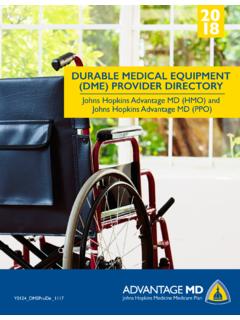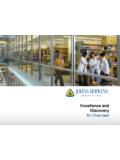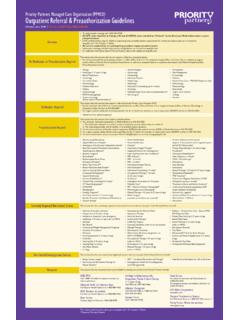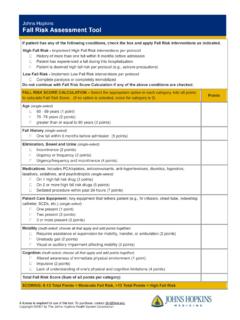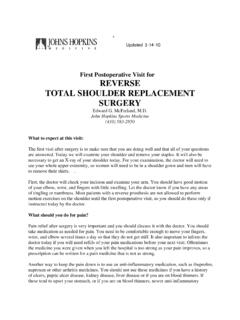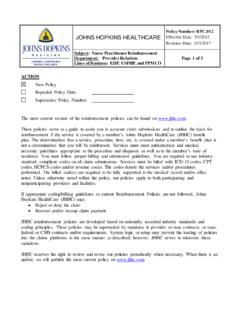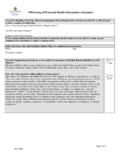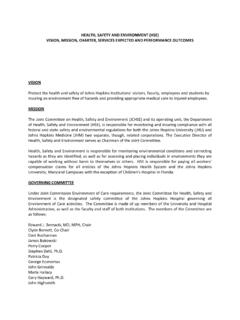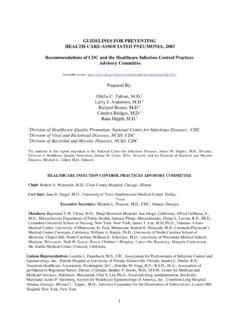Transcription of Ventilator-Associated Pneumonia (VAP) - Hopkins Medicine
1 1 Ventilator-Associated Pneumonia (VAP)Victoria J. Fraser, MD,Adolphus Busch Professor of Medicine and ChairmanWashington University School of MedicineDisclosures & Acknowledgements Consultant: Battelle, AHRQ HAI Metrics Project Grants: CDC Epicenters Grant, AHRQ R24 Complex Patients & CER Infrastructure Grant, NIH CTSA, Clinical Research Training Center, Barnes Jewish Hospital Foundation, Thanks to Marin Kollef, Sara Cosgrove, Trish Perl and Lisa Maragakisfor sharing slides2 Objectives Review the epidemiology of VAP Describe key issues related to diagnosing VAP Identify risk factors for & interventions to prevent VAP Discuss appropriate duration of therapy for VAPE pidemiology VAP.
2 Pneumonia occurring 48-72 hrs after intubation and start of mechanical ventilation 2ndmost common ICU infection 80% of all nosocomial Pneumonia Responsible for of all ICU antibiotics Increased risk with duration of mechanical ventilation (MV) Rises 1-3% per day Concentrated over 1st5-10 days of MV3 Epidemiology of VAP Approximately 300,000 cases annually & 5 10 cases per 1,000 admissions Prevalence 5 67% # 1 cause of death among nosocomial infections Increases hospitalization costs by up to $50,000 per patientMcEachern R, Campbell GD.
3 Infect Dis Clin North Am. 1998;12:761-779; George DL. Clin Chest Med. 1995;1:29-44; Ollendorf D, et al. 41st annual ICAAC. September 22-25, 2001. Abstract K-1126; Warren DK, et al. 39th IDSA. October 25-28, 2001. Abstract 829. Two forms: early vs. late onset Case control studies 30% -50% attributable mortality but not all studies suggest independent cause Higher mortality with Pseudomonas & Acinetobacter spp. Estimated cost savings $13,340 per VAP episode preventedEpidemiologyCCM 2003; 31: 1312-1317, CCM 2003; 31: 1312-1317, Chest 2002; 122: 2115-2121, CCM 2004.
4 32: 126-1304 Colonization AspirationPneumonia*Methicillin-resistan t Staphylococcus aureusMRSA* or other organismPotential Reservoirs: NosocomialPneumonia Pathogens Oropharynx Trachea Stomach Respiratory therapy equipment Paranasalsinuses Sanctuary (above cuff below cords) Endotrachealintubation decreases the cough reflex, impedes mucociliaryclearance, injures the tracheal epithelial, provides a direct conduit for bacteria from URT to the LRT5 PathogenesisVAP Microbiology Early onset (< 4 vent days).
5 Same as community acquired Pneumonia (CAP) Late onset ( 4 vent days) antibiotic resistant organisms Colonization of oropharynx & stomach precedes VAP Pathogenesis = micro aspiration6 Pseudomonas aeruginosa (17%), S. aureus (16%), Enterobacter(11%), Klebsiella Pneumonia (7%), E. coli (6%) S. aureus & P. aeruginosa increasing, decreasing enterobacteriaceae Anaerobes with aspiration Special groups: Legionella, Aspergillus, CMV, InfluenzaPathogensVAP is Hard to Diagnose Approaches to diagnosis Surveillance definition CDC/NHSN definitions VAP.
6 Now VAC IVAC Poss/ProbVAP Clinical definition for bedside use or studies Clinical Pulmonary Infection Score (CPIS) Clinician instinct invasive diagnostic approaches Surveillance definition and clinical definitions sometimes give different answers It s important for the people doing surveillance & people receiving the reports to understand the difference7 Surveillance: Methodology CDC (NHSN) definition is most commonly used for surveillance Requirements Active, patient-based, prospective Performed by trained professionals in infection control and prevention (IPs) Other personnel (or electronic systems) can be used for screening Final determination via IPOld Surveillance.
7 Case Finding Screening for cases often involved reviewing data from multiple sources Microbiology reports Pharmacy records Admission / discharge / transfer data Radiology / imaging Patient charts (physician and nursing notes, vital signs, etc.) Given the complexities of the diagnosis, retrospective surveillance may be difficult and inaccurate Hence move to more objective criteria8 Past VAP Surveillance: Definition Combination of radiologic, clinical & laboratory criteria Ventilator-Associated If ptwas intubated & ventilated at the time of or within 48 hrsbefore the onset of the Pneumonia No minimum time periodCDC/NHSN VAE, VAC, IVAC, Possible or Probable VAPNo more reliance on Radiography (due to subjective nature) Stable Vent pt.
8 > 2days, FiO2 & PEEP : For VACM inimum daily 1) FiO2 >.20 x 2 days, or 2) PEEP >3 cm H2O x 2 daysFor IVACAt least 2 of the following clinical criteria: 1) Fever (> 380C or > ) with no other recognized cause for feveror Leukopenia (<4000 WBC/mm3) or leukocytosis (>12,000 WBC/mm3) 2) New antimicrobials x 4 daysPossible VAP (1 needed) 1) New onset of purulent sputum or change in character of sputum 2) Positive cultureProbable VAP (1 needed) 1)Purulent secretion & positive culture 2)+ pleural fluid Cx, lung path, Legionella lab or Viral respiratory test9 Why Do Surveillance?
9 CDC Guideline for Prevention of Nosocomial Pneumonia to facilitate identification of trends & inter-hospital comparisons Joint Commission Accreditation for hospital requires that an infection control risk assessment be performed annually understanding of the areas in which patients are at risk for HAIs (including VAP) Some outcome measures need to be made in order to assess this risk CDC, MMWR 2004;53(No. RR-3)A Different Definition: Clinical Pulmonary Infection Score CPIS is the most well-known clinical scoring system for VAP diagnosis Complete at bedside (day 3) CPIS > 6 had a sensitivity of 93% and a specificity of 96% vs.
10 BAL quantitative cultures Subsequent studies did not find CPIS to be as accurate Better at predicting who does not have VAPP ugin et al. Am Rev Respir Dis 1991 143:1121-910 Clinical Diagnosis of VAP Presence or absence of fever, leukocytosis, or purulent secretions alone are not that helpful Combination of new radiographic evidence of infiltrate + at least 2 of these increases likelihood of VAP Absence of new infiltrate & <50% PMNs in lower airway secretions makes VAP unlikelyKlompas. JAMA. 2007;297(14) 2daysORFiO2by 15for 2daysAFTERM inimumof2daysofstableordecreasingPEEP/Fi O2 Ventilator-Associated Complication (VAC)Klompas M, et al.
